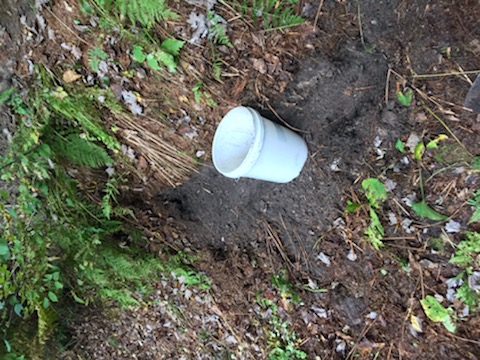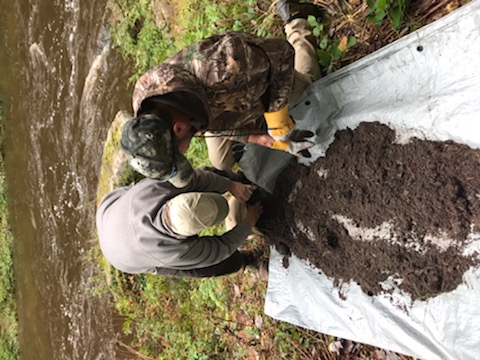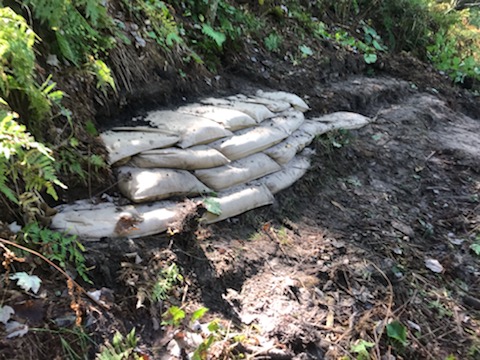Shoreline Stabilization
- clearwaterdells
- Sep 14, 2019
- 8 min read
Now that we have stairs, we have some shoreline erosion control to get in place. The stair installation disrupted an already fragile bluffside, and we need to begin the process of shoring that up.
In 2013, I had done much research on this topic. With our need to provide a safe path from the top of the bluff to the water, we needed something temporary that would be both environmentally-friendly and blend into the landscape.
The original path to the water when we bought the property was dangerous, and it almost stopped us from buying. But I looked at it as a problem to solve, and it did not take long to find an alternate path that was only slightly shorter in distance... but it would need some work to make it safer. We found a new path that was perpendicular to the bluff line, but then needed to curve the path to more parallel to the bluff line.
Envirolok bags were the answer. Both Bryan and Lorraine helped me on two separate occasions to install a curve in that new trail with the bags, and I was very impressed with how easy they were (if you consider filling and carrying 80-pound bags around easy), how they utilized the same soil you were excavating (since we are primarily sand), and used the whole concept of vegetation being the best thing to hold soil in its place. Sitting here six years after that initial installation and they are doing great.
I actually had a contractor who specializes in Envirolok bag installation quote me a job to bag the entire path, but in retrospect am very happy we did not go that path (no pun intended) because it was still a long and exhausting trip to the water... especially back up from the water.
Even though we found this new path to the water, it was still a bit treacherous and we ultimately concluded we needed a shorter and safer path to the water..... hence the stairway.
I knew once we were able to get to the water safely via the stairs, that we would need to do some shoreline stabilization. I did not realize we would have to get on this yet this year, but that is fine.... just something we need to do in order to make this last stretch safe also and keep things from washing out.
Our intention on this trip, which included me, Ron and Bryan, was to start on this bagging work. I had some leftover Envirolok bags from the 2013 project but knew I was going to need more. I dug back through my records to find how I purchased them in 2013, and while doing my research I found that Envirolok now produces a tan bag (the original bags were black). Since we are dealing with sand/sandstone on this bluffside, the tan bags would work better for us. While the black bags are completely covered with plants and moss, you can still see the black base a bit, much like you would see black base on a painting even though you paint another color over the black.
Since we are exposed to people paddling Hall's Creek, we want this to blend as much as possible with the natural landscape. I know once plantings take hold and moss growth will cover up the bags, but in the meantime the tan bags will blend in better than the black would.
Envirolok's office is located in Evansville, WI, a bit southeast of Madison. While a bit out of our way, it is convenient for us to get there on our way up to the property. We met with Eric who was able to give us much helpful advise on how to tackle the job we were preparing to do. We settled on (50) bag units (a unit consists of one bag, one tie and two spikes). We'll have to get more later, but I knew on this trip we would not be putting in 50 bags. When full, these bags weigh approximately 80 pounds each. That's 4,000 pounds.... I don't think that will happen all at once.
After leaving Envirolok and getting up to the property, we found what we expected.... flooding. This was not going to hamper the work we had to do, but with all of the tree and stair work this year, we have some rutted out driving areas and a few places that are holding water, something that has been almost a constant this year when we have never had that issue before. So we decided to set up camp on the fire lane.... where we used to have to camp before we had clearings and driveways into the property. But you know what? I really liked camping there again and will consider doing it again. At some point, this is where we will allow RV's to set up, as RV's will not be able to set up near the water at this point in time. So camping here made me remember how good of a place it is to set up camp.
We set up the popup, unloaded the truck, got some topsoil from Scholze's Ace Hardware, and were ready to get started. Bryan was driving up on his own, so he pulled in about the time we were going to get started. Bryan had a truck tire shred in front of him, damaging his car. And when he had to do some fixes off the next off-ramp, he strained his back. So it was not going to be smart to have Bryan do any of this work, so it was Ron and I.
Much of installing Envirolok bags is determining where to start. Where we needed to start was right below the stairway, but you can't really build a wall from the top down. So we needed to see how the wall was going to flow, where it was going to flow to, and where you needed to install that first row which is really the base of the entire wall system. So we did much talking and debating before we pushed our first shovel into the ground and started mixing and filling bags. We worked for a few hours, but then it was time for me to get our supper going. Ron and I filled and positioned five bags on Saturday.
The Envirolok bags use a mixture of sand and top soil at a ratio of 80/20. When we did the path in 2013, it was a mixture of 60% sand, 20% compost and 20% top soil. I think they discovered the compost breaks down over time resulting in a condition they call "slumping". I believe this means the bags lose a bit of their mass over time due to the compost breaking down. They now use the 80% sand and 20% topsoil mixture recommendation. Since we have mostly sand with organic material in it, we are using 80% excavated soil and 20% top soil.
In any case, it was time to wrap up working for the day to prep supper. I tried something new for camping on this trip..... a cheesy spaghetti and meatball casserole cooked in the dutch oven. While it turned out pretty good, I will do a few things differently next time. But it was a pretty good meal, and I even had some garlic bread to go with it.
A night of talk, laughter and music, but between Bryan's back issues, my pneumonia I was trying to get over, and just a long day in general had us going to sleep by 10 PM. Shortly before we headed to bed, we heard what we thought was a young raccoon being devoured by a bobcat or cougar. We don't think it was coyotes or wolves because they are normally in packs and you can hear them. Whatever it was, it was a loud and painful death, and it went on for quite some time.
I was awake the next morning by 6 AM, getting the fire started. It appeared we were going to get some rain later in the afternoon and during the night, so I decided we would pack up and leave mid-afternoon. Ron was up around 6:30, so after sitting around for a bit we figured we would get going on the work. We wanted to let Bryan sleep, and he had breakfast duties which allowed me to get to work rather than worrying about getting food for everyone which turned out to be very helpful in allowing Ron and I to get some bagging done.
Once we had an idea of what we were doing, we got better and faster at it. Five hours later and we had a total of 20 bags installed. I figure we can do three to four bags per hour. This 20 bags is a total of 1,600 pounds of soil-filled bags we handled and I was feeling it. Of course, we took a small break to eat a great breakfast of bacon, sausage, eggs and hash browns.... Bryan's specialty which helped us a ton.
We had originally planned on kayaking Trow Lake, but it was not to be. We packed up and were on the road by 1:00. I have some mixed feelings on this; I hate to dry out after rain and sometimes that weighs on me too much and causes me to avoid rain at times, while other times I am immune to the fact that it rains almost every time we are up there. After getting home, I have to set up the popup to dry it out, plus get all of my rain-soaked items all cleaned up and put away. This was a case of the thought of that making me want to leave before the rain started so I was not getting home after noon on Sunday and then working another four hours at home drying things out and putting them away. So we left early.
Ron was such great help on this trip; not just with his manual labor, but he has such great ideas on so many different things we are doing. And it helps we work really well together. Bryan felt bad he could not help more, but he has more than paid his dues on our journey, so him sitting out was the right thing for him to do. Besides, just the fact he took on breakfast duties meant that was two hours of my time I could work and get this initial piece done.
A good trip for us with good results. We have much more to do, but we have it started and did not bite off more than we could chew. Over time, we have some really good ideas on how to make that even better with the bags after we get this initial shoreline work done, and I am excited for working on those pieces. Seven years after buying the property, we can start working on one of the most important characteristics of the property.... the waterfront. And for us to do this in a way where nobody even notices anything out of the norm will be the fun part. Environmentally-friendly.... blended with the landscape..... this is what we are intending to do. Anybody paddling Hall's should not notice anything that does not blend into the natural landscape. This is theirs via their experience which includes their views. It is our job to make it appear as natural as possible, which in my mind what makes this whole thing so cool!!
As a side-note.... some of the bags in the pictures are not yet spiked. We will need to start the transition into the next section upward and did not want to make those permanent yet. There is a system of bags and tie-back bags (that go perpendicular to the normal bag direction), and we want to be able to tie back that next section and also tie it into this section properly. We also have a few partially-filled bags just to place to hold things in place. So in areas it may not look perfectly level or "bumpy", this is all due to these temp bags we have not yet spiked.



















































Comments